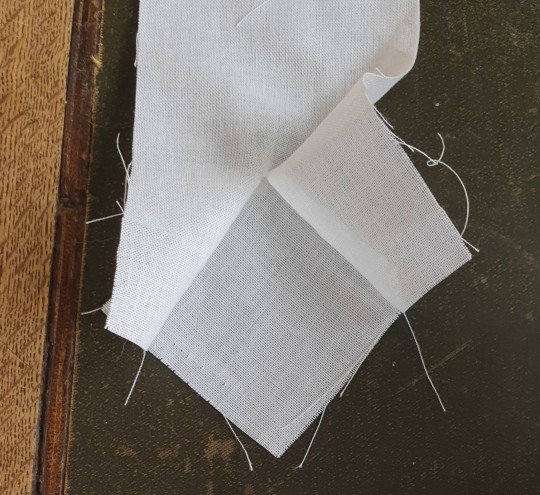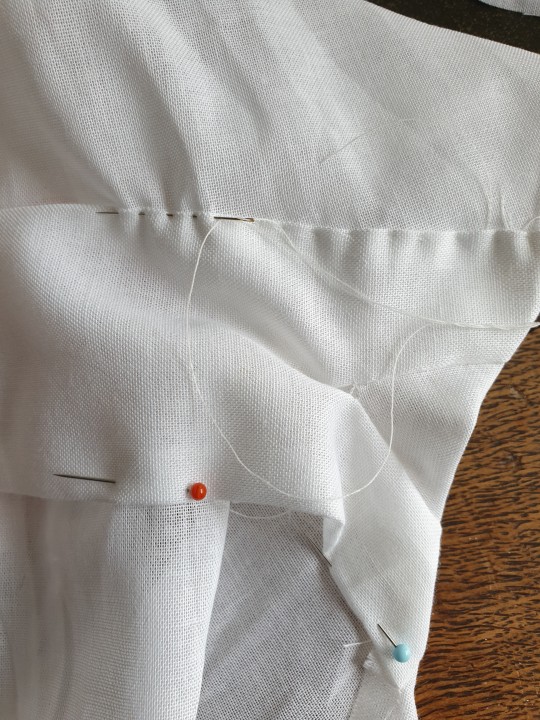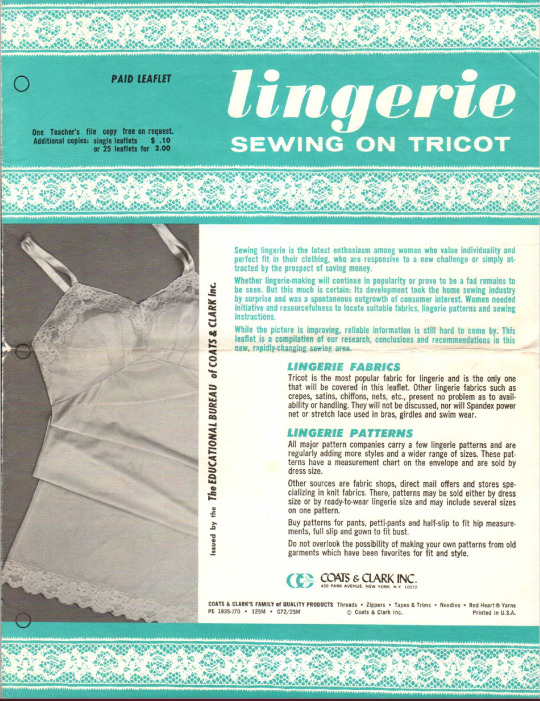#sewing resources
Text
Ryan Yip explains what a fabulous resource for sewers of all kinds the Royal School of Needlework Stitch Bank is.
#sewing#embroidery#stitches#database#needlework#textiles#fashion#fashion history#costume design#costume history#couture#ryan yip#tiktok#sewing resources#dressmaking#embellishment#decorative#video
69 notes
·
View notes
Text
Anyone able to point me towards resources for choosing fabric to line a Tunisian Crochet coat?
I've never made a lining for anything I've crocheted before and my hope is to prevent as much stretching over time as I can but idk what cloth/fabric would work best.
Any help would be wonderful ^_^
42 notes
·
View notes
Note
What advice would you give to someone who wants to start making plush? I've been making knitted toys for a few years now and would like to get into fabric plush, but it just looks super intimidating, especially the cutting/patterning part.
It's all a matter of perspective, since knitting shapes like toys looks super intimidating to me! But is some general advice I'd give to someone looking to start making plush with fabric:
Patterns: It's easiest to start off with a pre-made pattern, either a free one or one you purchase (links below). Start with something simple, meant for beginners, but interesting enough to motivate you. These come with fewer pieces and easier shapes. Once you get the hang of things, you can start researching pattern-making approaches and find one that works for you.
Fabrics: Start with something easy to work with. Felt and fleece are popular starter fabrics. I started with felt. Later you can explore minky and faux fur.
It helps if you organize your fabrics and pattern pieces beforehand. I make little piles of pattern pieces for every fabric color. That way I can trace and cut them all at once, and don't miss any.
Sewing: Look at it like a puzzle. You match up pieces one by one, and sew each seam one at a time. It's less intimidating if you only look at the next step, and just keep plodding along until you reach the last step, and voila, plushie!
Tools: You don't need anything expensive to start! Anything can be hand-sewn with just a needle and thread and scissors, available in any small cheap sewing kit. You'll probably also want a seam-ripper for inevitable mistakes (mine gets a lot of milage still!). Fabric can be old recycled clothing, or from the discount bin; stuffing can be fabric scraps or the guts of an old pillow. You can also get second-hand sewing machines that still work great.
If you're ready to dig into some more technical info, check out these comprehensive beginner's guides written by other skilled plush-makers. They've put a lot of time and effort into putting these together, and are much more in-depth than I could get into in a tumblr post. (Feel free to add more in the notes!)
NazFX: Naz's Beginner Plush-Making Guide (She also has video tutorials)
Makeshiftwings: Plush Making Resources (includes pattern sources, videos, etc.)
Metroidhat: Sewing techniques and materials guide for beginners
Cholyknight: Plush Sewing Basics
And remember there's no such thing as talent! Your first attempts may not succeed but keep working at it, and you'll get there.
My first plush (felt dolphin) with a recent plush (Red fox, 2022).

#art plush tips and resources#sewing resources#plush artist#I'm putting together a faux fur sewing guide but I wouldn't consider it for beginners
138 notes
·
View notes
Text
Floofy Shirt Sew-along: Step 2 - Gussets and Shoulders

This project starts with the most baffling part, the gussets. Not a thing used overmuch in day clothes. We’re gonna make it work though!
Morgan Donner’s gusset video explains the basic principle of underarm gussets really well. The explanation how to sew the point neatly is particularly useful for our neck gussets.
Take up your two shoulder pieces and two of your 8x8 gussets. You want them to end up looking like this:

Make a 6 cm long slit in each shoulder piece, like so:

Put one of your shoulder gusset squares under your folded shoulder piece so one point matches up with the end of your cut shoulder slit. Pin and sew.
Fold over the edges of the slit you just cut and lay it out so the newly open space forms a triangle.
Edit: I made a little video to demonstrate this!
Repeat for the second one.
The free triangle of the gusset is going to be inserted in the shoulder slit and the shoulder piece folded over to enforce the whole shoulder bit.
These are small pieces that will take a lot of strain, so I use backstitches. For people just starting out, this Bernadette Banner video on basic handsewing stitches is a good visual explanation of what the different stitches do.
Onto the body!
Fold the body in half (or one side 8cm longer if you want to be historical)
This fold is the shoulderline, mark it and find the middle of this line, this is where the slit down the front will go. Cut this slit downwards 16 cm (you can go lower if you want to be particularly barechested of course)
Your shoulder gusset pieces need to go in those shoulder slits and then folded over so they end up on top of the shoulder and the gusset seam allowances are neatly closed in. (I’m going to be posting pictures of each step of this as I do this.) You’re going to want to end up like this:
On the shoulder line, cut about 30 cms to each side (about 10cm should be left). Now your head should be able to go through.


Turn the edges of the shoulder piece under and sew them onto the body like in the picture above. The end that faces the shoulder seam can be left messy, they’ll disappear into the sleeves.
Tl:dr – insert your shoulder gussets in the shoulder pieces. Cut the neck and shoulder slits in the body. Insert the free gusset triangle in the shoulder piece, raw seams facing out, sew and flip over so the right sight of the shoulder piece covers the body like an epaulet with raw edges hidden. Sew down.
#floofy shirt sewalong#floofy shirt sewalong instructions#historical costuming#sewing resources#a talia original#this may be a two week step we'll see#i'm gonna do a separate post on the gusset into shoulder piece bit because it's much simpler when you see it done#it is imperative you stick your head through and flap around after you've cut the neck slit
54 notes
·
View notes
Text

I digitized a really neat leaflet about sewing lingerie and working with tricot fabric from the 1970s! You can find the whole thing on my blog.
#1970s fashion#historical fashion#sewing#sewing resources#historical fashion resources#20th century fashion#lingerie#sewing lingerie#zippyelly blog
6 notes
·
View notes
Text
The first time we went to the fabric store, we were overwhelmed since we didn’t know what to look for. we would become overwhelmed by the endless rows of fabric shelves in the garment district of New York, and as beginner sewists, we could have used a guide to help me identify fabrics we could successfully sew with.
We have created a guide to buying fabric for beginners just starting out in sewing. We have included a list of 12 fabrics that are easy to sew, along with some online stores where you can buy them. From casual cotton to dressy silks, quite a few fabrics are suitable for beginners. To ensure that you can find a beginner fabric for just about any type of garment, we chose fabrics that cover both ends of the spectrum.
#fabrics#fashion#cotton#linen#textile#scarf#fabric#patchwork#linencotton#linenlove#sewing patterns#sewing inspiration#craft#sewing machine#sewing#sewing resources#diy#crafting#arts and crafts
28 notes
·
View notes
Text
Novice sewing pattern: Cut out shapes. Line up the little triangles on the edges. Stitch edges together. We've also included step-by-step assembly instructions with illustrations.
Novice knitting pattern: yOU MUSt uNDerstANd thE SECret cOdE CO67 (73, 87, 93) BO44 (63, 76, 90) 28 (32, 34) slip first pw repeat 7x K to end *kl (pl) 42 * until 13" (13, 13, 15) join new at 30 pl for 17 rows ssk 27 k2tog mattress lengthwise BO and sacrifice a goat to the knitting gods. WHAT DO YOU MEAN YOU WANT "INSTRUCTIONS," I JUST GAVE THEM TO YOU
#knitting#no it's not a real pattern but I can't write one that makes sense because I have no freaking clue what any of that means#How do you make things that aren't basic rectangles#Why has every knitter I've asked for help just said 'patterns are easy; you just have to know how to read them' & then refused to teach me#Where do I even find a goat to sacrifice#How do I join the pattern cult#I am so confused#I've been knitting for almost a decade but I can only make scarves and potholders#I learned one (1) stitch by watching a YouTube video and none of my friends or family knit so I have no IRL resources#And nobody I meet seems to want to take the time to explain the rest to me#I taught myself to sew through trial and error but that doesn't really work with knitting because error is pretty much just... Unraveling?#Anyway sorry for the tag rant I'm just frustrated that I see pretty things I want to make but the instructions are in an alien language#And the gap between 'absolute novice' and 'intermediate' seems to be about 20 years of experience and formal instruction
409 notes
·
View notes
Text
WELP.

fucked around and found out!
Anyone got some good jeans-patching resources? I kinda hulked through this pair, the inner thigh's fabric is more or less SHREDDED to bits so it can't just be re-sewn, I need reinforcements
I have a bag of soft cotton flannel in a few different colours from when I was trying to sew plushies n things, that'll work right?
205 notes
·
View notes
Text
Embroidery Stitch Resource
A website with descriptions of the stitches, a short history of their use, and pictures and step-by-step instructions on how to make them! Really good resource for embroiderers and menders!
217 notes
·
View notes
Text

(The finished garment measurement is the one to use for seeing if it comes in your size.)
84 notes
·
View notes
Note
sewing / thread / embroidery pixels?












I hope u enjoy these!
Click here to download!
#web graphics#wrenzai#decome#pixels#graphics#old internet#old web#2000s internet#resources#neocities#carrd.co#sozai#req#sewing#embroidery#the bear one is so cute T-T#webcore#mini pixels
102 notes
·
View notes
Text
Virtual Fibercrafts Skillshare THIS SATURDAY!
From our Climate Action Youth Advocate and General Volunteers:
BFP’s first Skillshare will be on Saturday 1/27 at 7:00 pm EST! Stop by if you want to learn how to make warm clothing to donate to your local community!
Here are the supplies you will need: Fibercrafts require very little to get started. For crocheting, you will need yarn (in this demonstration we will be using #4 worsted weight yarn, but other weights can be used, you just have to adjust the gauge), and a crochet hook (we will be demonstrating on a H/8 or 5 mm hook. Others will work, and if using yarn of a different size, be sure to check the standard gauges for your yarn).
For sewing, you will need fabric that is stiff enough to work with (fleece, flannel, and cotton will work,) sewing needles, some sewing pins, and thread.
A note on materials: cotton yarn is best for beginners as it is stiffer, harder to break, and doesn’t fray as easily, while aluminum hooks are best for beginners as they withstand pressure. Dollar stores and Walmart sell sewing kits cheaply, which are acceptable for beginner projects. You may have to buy extra thread, or pins separately. Nylon and polyester threads tend to be the easiest to work with. Some beginners also prefer double-sided sewing tape in place of pins.
#announcement#reaux speaks#fiber crafts#fiber art#crochet#craftblr#crocheting#sewing#diy#arts and crafts#fiber arts#discord server#skillshare#skills#learning#how to#tutorial#art tips#art tutorials#art resources#art help#warm clothes#donations#donate#donation#winter#cold weather
52 notes
·
View notes
Note
Do you have recommendations for dress history youtube channels? I'm a very bookish person, an amateur historian of literature, and i want to understand the practical side of how clothes were made and worn. the pictures in my books only go so far.
Sure! There's some books that also go into the historical construction of clothing, most notably Janet Arnold's Patterns of Fashion series, which is an invaluable resource. Here's my most recommended YouTube channels who do historical costuming and talk about dress history in general:
Nicole Rudolph
Abby Cox
Morgan Donner
Cat's Costumery
Snappy Dragon
Bernadette Banner
priorattire
Adelaine Beeman-White
Karolina Żebrowska
Samantha Bullat
88 notes
·
View notes
Note
Your plushies look so so amazing! Have you considered selling patterns for them?
Thank you! I have considered it. Short answer, no, sorry. I won't be selling patterns for the foreseeable future.
Ok story time.
Last year I prepped a pattern for someone for use in a PhD research project. I learned very quickly that pattern prepping for someone else is a very different skill than designing that pattern and making the plush.
My patterns are loose pieces of tape and paper with scribbled labels. In order to prep them I have to digitize them (difficult for pieces that are larger than printer paper), label them clearly, and then create comprehensive instructions.
The one pattern I prepped, one of my simplest, took me about six months to prep. That was mostly because, well, I hated the entire process. It's slow. It's boring. It's just not my cup of tea. (It probably would have taken me a month if I'd enjoyed it, even so. It's very time-consuming.)
What's more, pattern sellers need to be available for troubleshooting and answering questions, and I don't really have the bandwidth for that. Or time for the array of other issues that pattern sellers have to contend with on a near-constant basis.
Even if I did sell patterns, it wouldn't be for every pattern I design. My plush are more than plush to me--they're my art, my soul, and I'm not really keen on my exact design choices being recreated. So while I am utterly delighted to inspire and share my process, there are some things I'd like to keep within my own artistic voice.
My hat off to all the plush artists who sell patterns. They are true heroes.
~~~
P.S. If you're looking for realistic canine patterns, FreakHound Studios has a couple nice wolves, and is currently releasing a fox pattern with a Q&A session set to go live on Patreon on Nov. 24th. NazFX also has a realistic fox pattern but I don't think she has it up on Gumroad yet.
#plush artist#sewing#answered asks#send me asks#I haven't heard back about the research project#I was probably too late tbh#plus some of my patterns have over 100 pieces which would make the instruction guide a legit novel#purringfayestudio#art plush tips and resources#purringfaye info
183 notes
·
View notes
Text
Sergers, or overlockers, are specialized sewing machines that stitch seams and decorative edges with multiple threads. In the same way as sewing machines, sergers are built to create certain stitches, and these stitches can differ from one machine to another.
How do serger stitches differ from other types of stitches? What are they used for, and how do you create them? This post will lay everything out for you.
#serger#sewing serger#stitches#embroidery#art#design#fabric#sewing patterns#sewing inspiration#sewing machine#craft#sewing resources#sewing#diy#crafting#arts and crafts
6 notes
·
View notes
Text
Historical Resources
Fabric & Supplies
Fabricmart - often very nice and affordable fabric. They frequently have huge sales.
Fabrics-Store - Cheap Linens and other fabrics. *
Renaissance Fabrics *
William Booth Draper - Historical Fabric including historical interfacing *
Burnley & Trowbridge - fabric, cravats/scarves, tools, etc.
Wooded Hamlet - Recommended to me by the tailors at Colonial Williamsburg for tapes and braiding. *
I often thrift many fabrics locally.
Patterns
Kannik’s Korner - mostly undergarment patterns
Laughing Moon Mercantile - Best patterns I’ve used but only sells digital patterns now.
Mrs. Depew - Vintage and late 19th century patterns, original and copies *
1827 Tailor Drafting Guide
Sellers
Townsends - clothes, tools, buttons, kitchenware, book reproductions, etc. (they have a men’s shirt that is less expensive than a handmade one but still very nice.)
Revival Vintage - Vintage reproduction menswear
Retro Fairy - Women’s vintage and historically inspired outfits *
American Duchess - Shoes, of course, but also stockings and buttonhooks
Lady Detalle - Very pretty historical reproduction jewellery *
Letter Seals - Wax and Wax Seals *
Penny River - general historical accessories *
Schmalberg Flowers - Decorative flowers made with original Victorian tools
Samson Historical *
Little Bits - Apothecary/ historical beauty products
Resources
The Art of Tying the Cravat - Book written in 1828
Pinsent Tailoring’s Pinterest
Historical Sewing Supplies 101 - Video
Costumer’s Manifesto - Has many resources to historical sources for costuming including drafting manuals and catalogues for the early 20th and late 19th century.
* I have not personally purchased from them but still seems like a good resource
* Friends and other costumers I’ve met have recommended or liked
149 notes
·
View notes